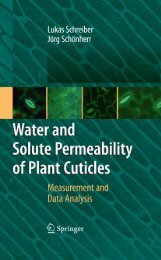Topics in Current Chemistry
Topics in Current Chemistry
Topics in Current Chemistry
Create successful ePaper yourself
Turn your PDF publications into a flip-book with our unique Google optimized e-Paper software.
Electronic Spectroscopy and Photoreactivity of Transition Metal Complexes 129<br />
term<strong>in</strong>ants <strong>in</strong> which the coefficients are variationally optimised. With<strong>in</strong> the<br />
CI formalism the configuration mix<strong>in</strong>g is <strong>in</strong>troduced (multi-determ<strong>in</strong>antal<br />
approach) but the predeterm<strong>in</strong>ed reference set of molecular orbitals is not<br />
reoptimised for the different electronic states. However most of the time and<br />
especially <strong>in</strong> transition metal complexes strong correlation effects affect the<br />
electron density. Therefore it is necessary to optimise the molecular orbitals<br />
accord<strong>in</strong>g to a multi-configurational scheme <strong>in</strong>clud<strong>in</strong>g static electronic correlation<br />
effects which describe the <strong>in</strong>teraction between two electrons <strong>in</strong> a<br />
pair at large separation space. The so-called MC-SCF method and its extension<br />
CASSCF (Complete Active Space SCF) [70, 71] or RASSCF (Restricted<br />
Active Space SCF) [72] methods have their orig<strong>in</strong> <strong>in</strong> this fundamental problem.<br />
These methods provide zero-order wave functions used as references <strong>in</strong><br />
subsequent CI, MR-CI or MS-CASPT2 calculations which take <strong>in</strong>to account<br />
the dynamical correlation effects describ<strong>in</strong>g the <strong>in</strong>teraction between two<br />
electrons at short <strong>in</strong>ter-electronic distance (so-called cusp region). Obviously<br />
the MC-SCF approach is even more crucial <strong>in</strong> excited states calculations<br />
where electronic states mix<strong>in</strong>g and dramatic changes of electron density<br />
dur<strong>in</strong>g the excitation have to be taken <strong>in</strong>to account. The large variation <strong>in</strong><br />
the number of d electrons pairs among the various electronic states is one<br />
major difficulty when correlated methods are applied to transition metal<br />
complexes. The most widely used MC-SCF method is the CASSCF based on<br />
a partition<strong>in</strong>g of the occupied molecular orbitals <strong>in</strong>to subsets correspond<strong>in</strong>g<br />
to how they are used to build the wave function. The problem is reduced to<br />
the partition <strong>in</strong>to sets of active and <strong>in</strong>active orbitals and to a selection of<br />
correlated electrons. This discrim<strong>in</strong>at<strong>in</strong>g strategy based on the physics and<br />
chemistry of the study <strong>in</strong>cludes all configuration state functions (CSFs)<br />
which are generated by distribut<strong>in</strong>g the active electrons among the active orbitals<br />
<strong>in</strong> all possible ways consistent with the sp<strong>in</strong> and the symmetry of the<br />
wave function. In practical applications where the number of configurations<br />
may exceed 10 6 and the size of the active space may vary between 2e2a<br />
(where 2 electrons are correlated <strong>in</strong>to 2 active orbitals) and 16e16a (where<br />
16 electrons are correlated <strong>in</strong>to 16 active orbitals) such a partition<strong>in</strong>g is not<br />
straightforward. The validity of the subsequent MR-CI or MS-CASPT2 treatments<br />
depends entirely on the quality of the CASSCF wave function and this<br />
strategy not easily automated cannot be used as a black-box. Most of the<br />
time the orbitals are optimised for the average energy of a number of excited<br />
states large enough to <strong>in</strong>clude the electronic spectrum of <strong>in</strong>terest. This procedure<br />
avoids roots <strong>in</strong>versions as well as convergence problems and leads to<br />
a set of orthogonal wave functions of given sp<strong>in</strong> and symmetry and to transition<br />
densities of reasonable accuracy used <strong>in</strong> properties calculation (dipole<br />
transition moments). The transition energies accuracy is obta<strong>in</strong>ed by<br />
the addition of the rema<strong>in</strong><strong>in</strong>g correlation effects by means of MRCI or<br />
MS-CASPT2 calculations. If the active space can be chosen large enough accord<strong>in</strong>g<br />
to the physico-chemical aspect of the problem results of high accu-







